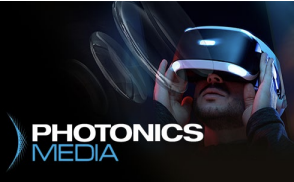REDMOND, Wash. – November 8, 2021 – Radiant Vision Systems, a leading provider of optical test and measurement solutions for displays and light sources, announces that it will present a webinar in cooperation with Photonics Media titled “Novel Solutions for XR Optical Testing: Displays, Waveguides, Near-IR, and Beyond.” Led by augmented, virtual, and mixed reality (AR, VR, MR) solutions experts from Radiant’s team, the webinar will take place during a live broadcast on November 18 at 10:00 A.M. PT (1:00 P.M. ET). The webinar includes a 45-minute presentation followed by an audience Q&A session with the presenter.

Image credit: Radiant Vision Systems
The landscape of extended reality (XR) devices is incredibly diverse. XR technology has driven innovation in optical design, yielding an array of components and architectures that address different requirements for immersion, superimposition, responsiveness, resolution, and form factor. Designs utilize a range of display technologies (LCD, OLED, microLED), projection components (diffusers, gratings, diffractive or holographic optical elements (DOE, HOE), lightguides, sensing systems, and headset configurations to ensure optimal visual experiences in AR, VR, and MR environments. While this diversity has allowed optical designers to tackle XR visual requirements in different ways, it has also necessitated new test and measurement solutions to evaluate visual performance from the component to the system level.
“There is a singular goal across XR optical design: provide the best near-eye visual experience for the user,” says Davis Bowling, Sales Manager — North America at Radiant Vision Systems. “Defects at any point in the component architecture of an XR headset have to be detected and addressed to make sure manufacturers can meet this goal. This is where optical testing comes in. Typically, test solutions for XR apply imaging and light measurement to inspect and quantify the output of visual elements throughout the headset architecture. This could be anywhere from the display module stage to the meta-lens to near-infrared (NIR) light sources used for sensing, all the way to the final stages of testing within the completed headset.”
Visual inspection and measurement can be efficiently accomplished by combining photometric imaging, lenses, and software to test the unique characteristics of each component. While a display module may require inspection of pixel-level defects, images projected via lenses and lightguides must be evaluated for brightness, sharpness, distortion, and aberration. NIR light sources that enable eye tracking, hand tracking, and proximity detection have their own measurement requirements, including the scope and radiant intensity of LED and laser distributions. At the final assembly, measurement equipment must evaluate the complete field of view as seen by the user within an XR headset. This means capturing an area up to 120 degrees horizontal from the eye position, fitting measurement optics inside any headset form factor, and accounting for left and right eye positions.
“Photometric imaging systems are the fundamental element of a visual test and measurement system for each stage of XR design,” states Bowling. “However, there are several considerations engineers need to make to ensure they choose the optimal imaging system, lens, and configuration for each job. Radiant’s history includes 30 years of developing optical test equipment for display test, light measurement, and NIR source evaluation, which we’ve applied to create novel solutions for XR environments. I’m excited to be able to share some of these solutions with the photonics and optics community and provide these engineers with accurate, fast, and easy-to-apply tools that help them optimize their XR designs.”
At the upcoming webinar, presenter Davis Bowling will discuss XR optical components, focusing on their measurement needs and challenges. He will introduce imaging equipment and test system configurations from Radiant that address each component and viewing condition, with examples from test and analysis software. Applying a diverse background in industrial imaging metrology, Bowling has supported customer applications with photometric, colorimetric, and radiometric inspection systems since 1997. At Radiant, he is responsible for facilitating solutions for unique customer applications worldwide—including emerging AR, VR, and MR display types and optical geometries. Davis has a deep understanding of the technical considerations required for a successful implementation and shares his expertise in measurement equipment by providing a consultative approach to system integration.
The November 18th webinar “Novel Solutions for XR Optical Testing: Displays, Waveguides, Near-IR, and Beyond,” is currently open for registration through the Photonics Media website: www.photonics.com/Webinars/Novel_Solutions_for_XR_Optical_Testing_Displays/w363